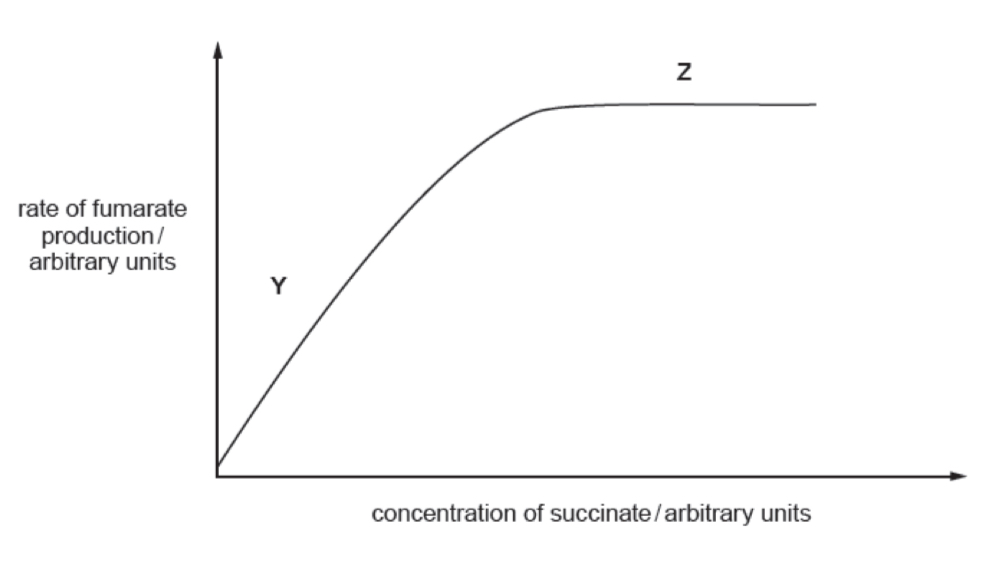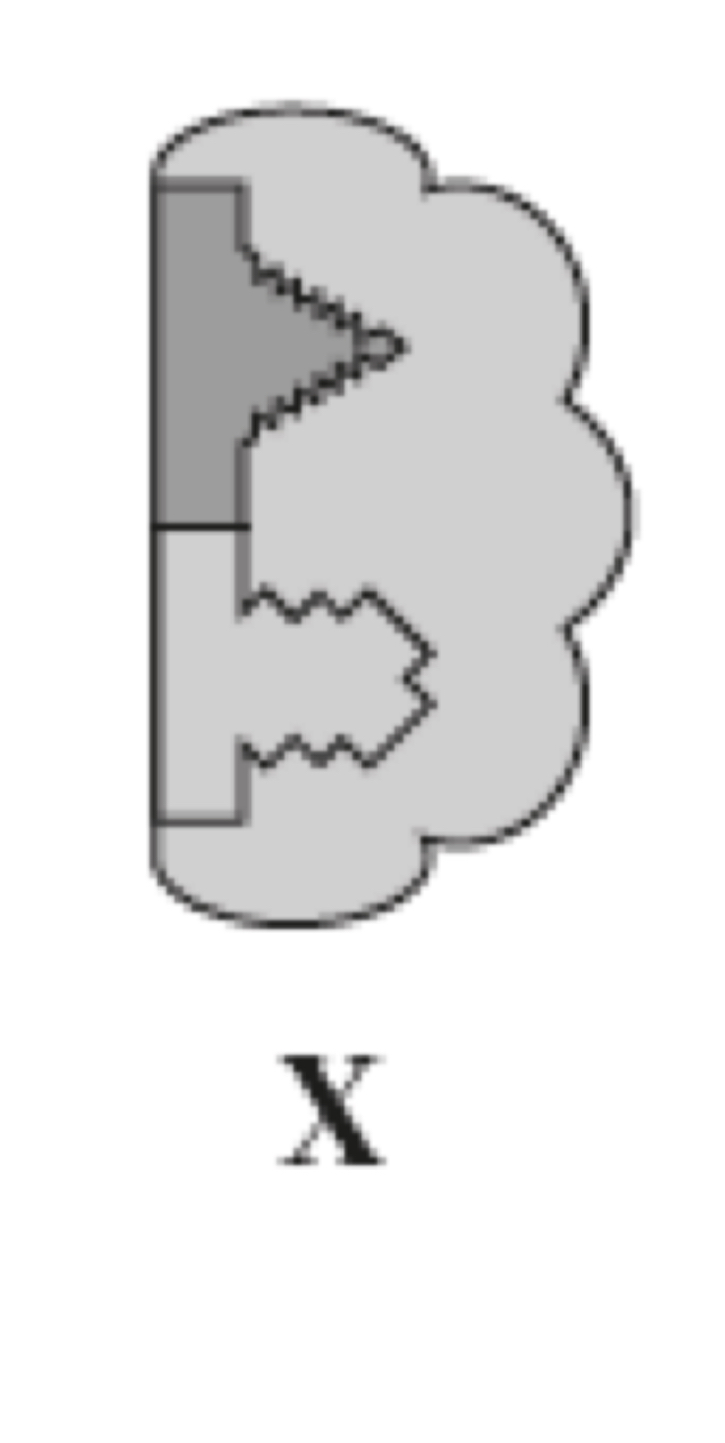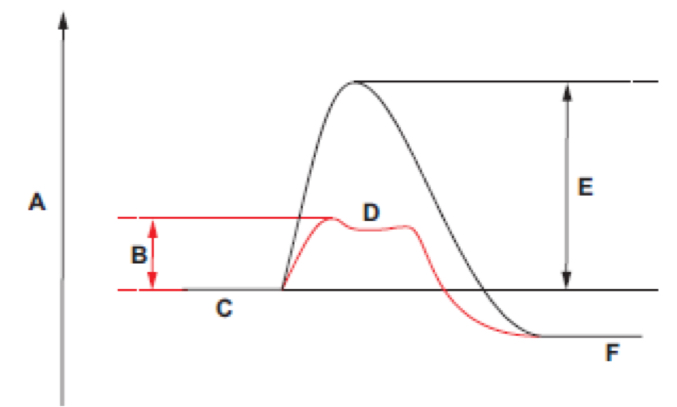enzymes
1/29
There's no tags or description
Looks like no tags are added yet.
Name | Mastery | Learn | Test | Matching | Spaced |
|---|
No study sessions yet.
30 Terms
Using your knowledge of enzyme structure explain why this is the only reaction succinate dehydrogenase can catalyse
The active site of succinate dehydrogenase has a specific shape , succinct (the substrate) has a complementary shape and therefore fits into/ binds to the active site
Graph showing energy changes that occur during a chemical reaction
Drawing a line to show energy change that would take place if an enzyme was present —> line starting and finishing must be at the same point but the activation energy is lower

State the factor that is limiting the rate of reaction and give evidence from graph to support your answer
Concentration of succinate (substrate) because as the concentration of substrate increases the rate of reaction / rate of production of product increases
Explain what is limiting the RoR when the graph plateaus
The concentration of enzyme (succinate dehydrogenase) as all of the active sites are occupied
Using the diagram of succinate and malonate to explain how malonate inhibits succinate dehydrogenase
malonate has a similar structure to succinate (substrate) has a complementary shape to the active site, malonate binds to the active site preventing succinate (substrate) binding so fewer ESC are formed
Describe and explain the effect of temp on the rate of activity of the enzyme
Increase in rate from ..° to …°, increase in KE so molecules move faster , more successful collisions so more ESC formed up to optimum temp , there is a fall from …° to …° as above optimum temp there is a increased vibration causing hydrogen bonds to break resulting in loss or change of shape of the active site, enzyme denatures
Graph shows effect of temp on bacterial amylase, state the diff between bacterial amylase and amylase found in humans
Enzymes have different optimum temps, human amylase has an optimum temp of 37°C bacterial amylase has an optimum temp of .. (shown in the graph) so human amylase denatures at a lower temp
Which theory represents activity of lysozyme
Induced fit model

Name given to structure
Enzyme substrate complex
How do enzymes bring about thier effect of speeding up reactions
Lower the activation energy
What characteristic of the enzyme at the end of a reaction is visible in both diagrams
Enzyme/ active site is unchanged so can be reused
3 factors which affect enzyme activity
Temp
pH
Enzyme concentration
Substrate concentration
Distinguish between intercellular and extracellular enzymes
Intracellular→ inside the cell
Extra cellular → outside the cell
Advantage of immobilising enzymes
Product not contaminated with enzyme
Enzyme can be reused
Can withstand/ tolerate a wider range of pH
Can be used in a continuous process
Increases temp range over which they can be used
Suggest why reducing the flow rate of material through the column would result in an increased volume of products
Increases contact time between enzymes and substrates , more time for immobilised enzymes to digest substrate, more successful collisions/ more enzyme substrate complexes formed
Explain the results for temp above 40°C (graph decreases from 40° and falls to 0 at 60°C)
Between 40 to 60°C there is a decrease in the product produced, enzymes are denaturing, above 60°C no product is produced so enzymes are denatured hydrogen bonds break, tertiary structure deformed active site changes shape, substrate can longer fit into active site so fewer ESC formed
Explain why a higher yield of products was produced using free enzymes between these temps than using immobilised enzymes
Free enzymes can move, increase chance of successful collisions, more ESC form
Explain why enzyme bound to gel membrane surface produces more product than enzymes immobilised inside beads
Membrane bound enzymes are more accessible to substrate, for enzymes immobilised inside beads substrate has to diffuse or pass into bead
Describe what is meant by the term biological catalyst
A protein Produced by living cells, speeds up the rate of a chemical reaction without being used up or changed themselves
Suggest why different enzymes are needed for remove different types of stains
Enzymes are specific
Each stain / protein has a diff shape, diff shaped substrate
Would not fit one active site, three different active sites are needed
Explain using graphs why reaction at 60° wouldn’t be recommended
(Graph shows all enzymes denature at 50°) → at this temp all three enzymes are denatured, have no activity due to breaking of hydrogen bonds, active site deforms, prevents enzyme substrate complexes forming so no ESC form, prevents successful collisions
Graph shows 3 enzymes, explain why reactions works best at this temp
all 3 enzymes have high activity/ are working well at this temp
Explain how molecule works as a competitive inhibitor
It has a similar structure to substrate, complementary to the active site of enzyme
Less ESC formed, more enzyme inhibitor complexes formed, fewer successful collisions
Less substrate is converted and reaction decreases so concent of product decreases there is less product
Increasing comment of substrate reduced effect of inhibitor
Suggest why this might be useful to a cell
Prevents build up/ overproduction of end product, stops when sufficient or enough product is made, regulating production of … product, stops …( product) reaching toxic levels
Describe how enzyme alcohol dehydrogenase can catalyse conversion of ethanol into ethanal
Enzyme has a specific shaped active site , ethanol substrate has a complementary shape, the two fit together to form an enzyme substrate complex
Fixed mass of ethanol was added to test tube containing enzyme alcohol dehydrogenase, test tube was incubated and the mass of ethanal produced over time was recorded shown in a curve graph (time against mass of product)
reason for difference in rate at the start (time 0) and when time is 30s → at the start the rate of reaction is higher as the concent of substrate is high, the concent of the enzyme is the limiting factor
At 30s→ the rate of reaction is lower and the concent of substrate decreases, the convent of substrate becomes the limiting factor
Explain how the induced fit mechanism differs from lock and key model
Lock and key active site shape already fixed, complementary to substrate
Induced fit active site changes shape when substrate binds
Protein ADK is an enzyme involved in regeneration of ATP in a muscle, suggest why the activity of ADK would be an advantage to muscle
ATP can be regenerated quickly, more ATP for muscle contraction

Energy level of the products of an enzyme catalysed reaction: F
Activation energy of an enzyme catalysed reaction: B
energy level of an ESC: D
Energy level of the reactants: C
Activation energy of a non enzyme reaction: E
Ethylene glycol is converted into glycoaldehyde, this reaction is catalysed by alcohol dehydrogenase, treatment of ethylene glycol involves giving patient alcohol, graph shows rate of glycoaldehyde production when ethanol present and when absent against concent of ethylene glycol
Ethanol and ethylene glycol (substrate) must have a similar structure, must both be complementary to the shape of the a five site of the enzyme (ADH), ethanol act as a competitive inhibitor, when ethanol binds to the active site it prevents ethylene glycol from binding , fewer ESC formed which reduces the rate of rpsouvripn of glycoaldehyde/ product